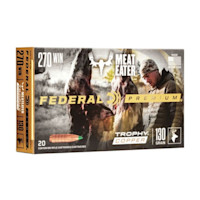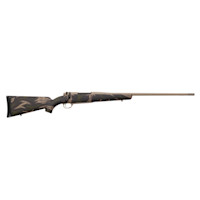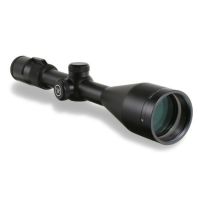Last month, I called the .30-06 Springfield and the .270 Winchester “the most frequently debated rifle cartridge matchup on the planet.” Comparing the .308 Winchester and the 6.5 Creedmoor might give that statement a run for its money.
No one doubts the .308 Win.’s ability to take big game. It’s been doing yeoman’s work in North America since its introduction in 1952. But the long-range target shooting craze has produced an equally voracious interest in long-range hunting, and the 6.5 Creedmoor has been dubbed by many as the .308’s natural successor.
The 6.5 cut its teeth in the target shooting world following its introduction by Hornady in 2007, and hunters, including several of the MeatEater crew, have been quick to adopt the cartridge. Whether it deserves to overtake the .308 has been debated ad nauseum, but at the risk of mixing metaphors, I’m happy to throw my two cents into the ammo can.
Ballistics Creedmoor fanboys go crazy over the 6.5’s ballistic potential. The argument is pretty simple: At close range (think: within 400 yards), the .308 Win. hits a little harder. But most 6.5 bullets retain more velocity at extended ranges, which eventually negates the Winchester’s power advantage.
Federal’s Trophy Copper options are a good example. The company’s 165-grain Trophy Copper .308 Win. travels 2700 feet per second (fps) at the muzzle and produces 2671 foot-pounds (ft.-lbs.) of energy. The 120-grain Trophy Copper 6.5 Creed, by contrast, travels 2875 fps at the muzzle but only produces 2200 ft.-lbs. of energy.
These numbers change based on bullet weight and load construction, but the Winchester’s 400 ft.-lb. muzzle energy advantage is typical. Whether that energy drops more animals is a debate for another article, but hydrostatic shock is (probably) a real phenomenon, so it very likely could.
The .308’s energy advantage starts to slip at greater ranges. Going back to the Trophy Copper examples, the .308 Win.’s advantage drops to +189 ft.-lbs. at 400 yards and only +59 ft.-lbs. at 800 yards. In addition, the 6.5 Creed Trophy Copper bullet falls 4.5 fewer inches at 400 yards and 35 fewer inches at 800 yards.
You can see why long-range shooters have flocked to the 6.5: Less bullet drop and more velocity retention means more shots on target, and those advantages may well translate to the field.
Of course, you may not want to shoot animals at long range. Many hunters don’t, and for good reason. Compensating for wind and bullet drop is difficult even in the best of circumstances, and we at MeatEater always recommend getting as close to an animal as possible before pulling the trigger.
Usually, that means getting within about 400 yards, which in this common hunter scenario gives the ballistic advantage to the .308 Win.
Winner: .308 Win.
Shootability Shootability is not a real word (for those wondering), but we use the term here to describe how hard a cartridge hits your wallet and your shoulder.
The 6.5 Creedmoor’s famously light recoil makes it a favorite among new hunters, young hunters, and all other hunters who aren’t masochists. Recoil impulse depends on rifle weight, bullet weight, and load construction, but all things being equal, the 6.5 Creedmoor produces about 25% less recoil than a .308 Win.
That toned-down recoil helps prevent flinching and allows hunters to make shots in more awkward shooting positions. The .308 Win. doesn’t kick as much as other .30-caliber cartridges, but you’ll feel a noticeable (albeit slight) difference when shooting the 6.5 and the .308 side by side. It’s also worth noting that in my experience, the 6.5 Creedmoor sounds better when using a suppressor.
I’ve said this before, and I’ll say it again: it’s tough to compete with NATO cartridges when it comes to cost and availability. The same holds true here.
Midway USA (one of the largest ammo dealers online) offers 168 products in the .308 Winchester category. You can still find steel-cased Russian garbage for less than $1 per round, and decent hunting cartridges are available for $1.50 per round.
The 6.5 Creedmoor isn’t quite as cheap or readily available. Midway offers 96 products in this category, and the cheapest clocks in at $1.35 per round. Decent hunting cartridges aren’t expensive, but they cost about $0.35 more per round than the same Federal line in .308 Win.
Availability is skewed by the ammo shortage, but that’s not likely to end any time soon, so if you’re in the market for a hunting rifle you might as well take it into account. There are currently two types of 6.5 Creedmoor available at Midway, while you can find 35 options for .308 Win.
For a hunting rifle, I’m less worried about ammo cost and availability than about making a good shot when the time comes. For that reason, this round goes to the Creed.
Winner: 6.5 Creedmoor
Versatility If you could only choose one cartridge, you’d want it to be able to take everything from varmints to large game. Both the 6.5 Creedmoor and the .308 Win. are versatile, but in factory cartridges, the .308 Win. boasts a great range of bullet weights.
Federal offers .308 Win. cartridges using bullets ranging from 110 grains to 180 grains (70-grain spread) while the 6.5 Creedmoor can only be had in bullets ranging from 95 grains to 140 grains (45-grain spread). You can find factory cartridges with heavier or lighter bullets, and you can also roll your own, but this spread is fairly typical.
So, what does this mean in the real world? Both cartridges can target varmints and predators with lighter bullets, but hunters can use the .308 Win. to target heavier game.
Don’t let anyone tell you that the 6.5 can’t handle elk—the MeatEater crew has enough elk meat stashed away to prove those doubters wrong. But there’s no denying that the .308 Win. is more frequently loaded with heavier bullets, which, combined with the .30-caliber pill’s larger cross-sectional area, make it more devastating for very large game.
Firearm availability is great for both cartridges. You’re more likely to find a semi-auto chambered in .308 Win., but you can still find modern sporting rifles in 6.5 Creedmoor. Every major manufacturer offers multiple bolt-action options in both chamberings, and the Weatherby Vanguard MeatEater Edition can be had in either cartridge.
Winner: .308 Win.
And the Winner Is… As the winner of two out of three categories, the .308 Win. deserves the nod as the overall victor.
But there’s a giant asterisk beside that championship. If you’re hunting at extended ranges or are worried about wind drift, the 6.5 is better. If you care more about recoil than anything else, the 6.5 is better. If you’re looking for extreme accuracy, I’ve had better luck with factory rifles chambered in 6.5 than with those chambered in .308.
There’s a reason the .308 Win. has stuck around for so long, but as with most decisions related to firearms and cartridges, the best choice depends on your hunting situation, personal preferences, and target animal.
Overall Winner: .308 Win.*






